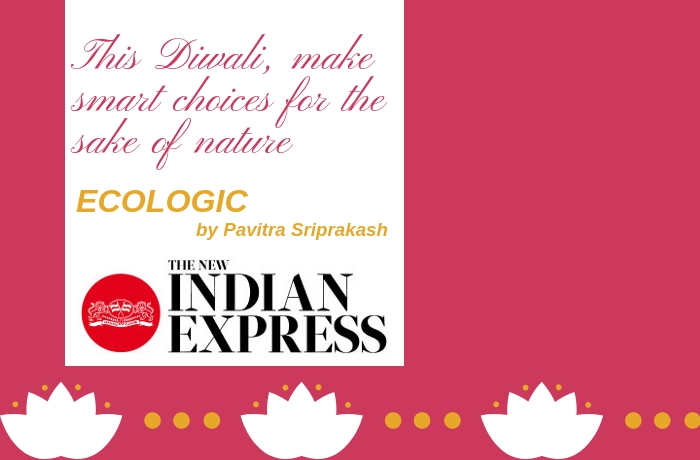02-Nov-2018, Pavitra Sriprakash, Director and Chief Designer, Shilpa Architects Planners Designers Pvt. Ltd, in her weekly column on Sustainability, writes about “adopting smart solutions for the sake of nature”.
Click here to read the article on The New Indian Express Site, or read the full article below. As always, we look forward to your feedback and suggestions at studio@shilpaarchitects.com
This Diwali, make smart choices for the sake of nature
Diwali is by far the country’s block buster festival. It’s time for fun and frolic when families come together to celebrate the traditional festival of lights. Having a ‘Green Diwali’ is something that may not be the first thing that pops into our heads, but we do have to stay focused on the environmental impact of this festival and do our bit to be sensitive amidst all the celebrations.
Crackers are obviously a standout environmental issue and are especially under the scanner for all sorts of hazardous reasons — from workers safety, safety while being set-off, noise levels, air pollution and to top it all drainage of precious foreign exchange by Chinese products. Around the country state pollution control boards assess and evaluate the permissible noise pollution level of firecrackers. When the really big ones go off, air vibrates at such a high magnitude that it activates sensors triggering burglar and car alarms.
According to the environmental laws of India the ‘Safe noise level’ is about 90 Db. Experts warn that continuous noise levels in excess of 90 decibels can cause loss of hearing and irreversible changes in the human nervous systems. The World Health Organization (WHO) has fixed 45 decibels as the safe noise level for a city. Metropolitan areas in India usually register an average more than 90 decibels. During Diwali this number jumps and often exceeds 125Db, which completely disrupt the natural environment. Sounds are 4-7 times louder for dogs when compared to humans, which makes Diwali particularly stressful for them.
Animal activists are worried about the effect of the crackers on stray dogs and cats on the streets and they struggle to find shelters that keep them safe during this time. Many house pets also go missing at this time of the year as they run away from homes in panic and are unable to retrace their steps. The smoky early morning sunrise on Diwali is characteristic of another major aspect of crackers — air pollution.
While some are more polluting than others, rest assured that burning cracker waste emits deadlier toxins into the environment. Air pollution shoots up 50% during this time in major Indian cities as levels of oxides and dioxides of sulphur and nitrogen skyrocket. Apart from this, suspended particulate matters (SPM), respirable suspended particulates (RSP) also increase making it impossible for people suffering with breathing disorders like asthma. The air and noise polluting aspects of crackers are meant to be monitored before these can be stocked for sale, but most often crackers fail to meet environmental safety standards.
There is also a lot of paper and cardboard garbage created by the packaging which cannot be recycled or repurposed. It is left lying on the roads only to become part of our landfills. So this time around, be an informed consumer and check with the stores before purchase to make smart choices for your family. Or better still have a joyful, bright and cracker free celebration and feel great about the fact that you are saving our planet and its creatures by doing so – Happy Diwali!



